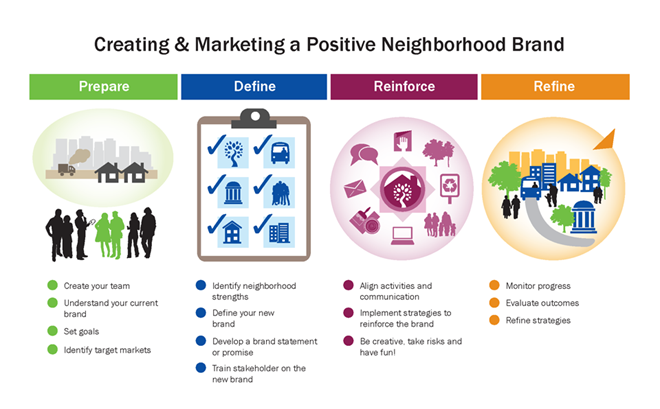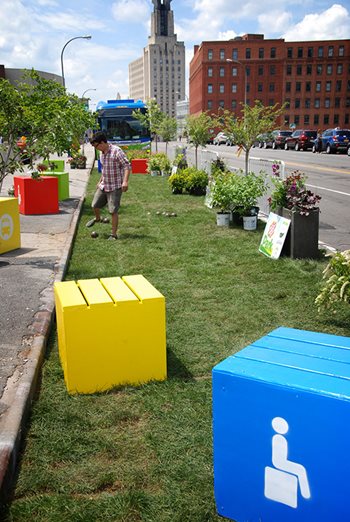The third round of the Neighborhood Marketing Program is off and running. In 10 communities across the country, marketing teams comprised of residents, business owners and other partners are moving to the logo design phase of the process. But, how did they get there? Where did they start?
NeighborWorks Community Stabilization staff visited NeighborWorks Rochester for its campaign kick-off. During the week, the marketing team gathered to identify the challenges as well as the assets that can be leveraged for neighborhood promotion.

Although no campaign kick-off is the same, each program participant must answer the following questions before launching a neighborhood marketing strategy:
How do current residents describe living in the neighborhood?
This question encourages residents to identify both positive and negative neighborhood characteristics. It is an opportunity to discover potential assets such as unique architecture and a spirit of trust between neighbors. These “gems” can be included in the narrative communicated to others about the neighborhood’s identity.How do outsiders perceive the same neighborhood?
Understanding the perception of others helps identify issues that should be addressed before marketing a neighborhood. Blighted homes in need of façade improvements or unattended vacant lots may lead an outsider to believe that a block is unsafe. Taking steps to address these conditions helps reinforce positive messages.
What does the real estate market look like?
What are the current market conditions? Is it severely distressed? Have home prices been on the decline? What comprises the housing stock—single-family homes or multifamily units?How many are occupied versus vacant? The Census Bureau, HUD, National Association for Relators and Zillow websites offer housing market statistics to support your inquiry.
 What social indicators are important for branding and promoting a neighborhood?
What social indicators are important for branding and promoting a neighborhood?
Some data are less market-oriented and more focused on community-level indicators such as resident engagement. In Rochester, residents located within the Triangle neighborhood (the area between Culver Road, Merchants Road, East Main Street and Winton Road) participated in an asset-mapping project in which they documented all commercial properties, residential areas and parks.Through this process, they identified “tree deserts” to which they would eventually target funds to do plantings.
Are your neighborhood revitalization goals S.M.A.R.T.?
Improving the maintenance of commercial and residential properties is a goal. Funding two decorative board-ups and planting a community garden over the course of three months is a S.M.A.R.T goal.S.M.A.R.T. goals are specific, measurable, achievable, results-focused and time-bound. NeighborWorks Rochester hosted a façade makeover competition open to Triangle and surrounding homeowners and businesses.The program was intended to improve the overall appearance of the neighborhood. Since its inception, the competition has gained increasing interest; owners of n properties adjacent to the winners pursued their own improvements, adding to the curb appeal.
How will you encourage resident engagement?
This question is designed to help you better understand your strongest asset, residents. They serve as the mouthpiece for the community. Consider hosting a town hall meeting or a pop-up featuring area vendors to facilitate interaction.This can also be an opportunity for residents to give feedback on revitalization activities or take the lead by conducting community surveys.
What previous marketing strategies have succeeded or failed?
This is important to answer before framing your neighborhood marketing strategies. Which programs or activities improved the community?Did any fail?This reflection is necessary to prevent spending time on efforts that did not work in the past and to assure that you make note of those worth replicating.
What social media outlets are available? How have they been used and by whom? Are there additional vehicles that can be leveraged for communication and engagement?
Facebook is a great tool for sharing neighborhood updates, and promoting events. Consider using Pinterest to collect images from the neighborhood that will inform and “spice up” the logo-development process. Another tool to check out is Periscope, is a live video-streaming service that allows you to capture events and promote them as they happen.
What is your short-term agenda?
Define where you want to see yourself and your neighborhood next week, next month and next year. Remember those S.M.A.R.T. goals? Identify some low-hanging fruit to experience quick wins along the way.
What is your long-term vision?
Where do you see yourself and your neighborhood in the next five or 10 years? This is an opportunity to envision the outcomes of a successful marketing campaign, such as a strong business corridor, safe streets, shared public spaces and increasing home values. Identify the partners you may need now and in the future to support your efforts. Implement plans to strategically engage those partners.
Are you about to embark on a neighborhood marketing campaign? Share your thoughts!

